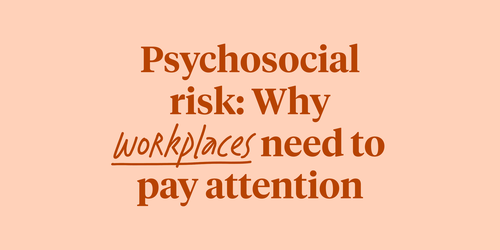
How to foster psychological safety and help your team thrive

Psychological safety has become a buzzword in recent years, but it was first coined by Amy Edmondson, a Harvard Business School professor, in 1999. In her research, she defined psychological safety as "a shared belief by members of a team that the team is safe for interpersonal risk-taking."
To put it simply, when a team has psychological safety, its members feel comfortable voicing their big ideas, sharing criticisms, and taking risks – without the fear of embarrassment, judgment, or reprimands.
Remember when your elementary school teacher encouraged your class with a sentiment like, "There are no stupid questions!"? Psychological safety is the same concept applied in the workplace.
Why is psychological safety in the workplace important?
Anybody familiar with Maslow's hierarchy of needs – a theory often adapted for the management of work teams – will recall that "safety" is one of the base tiers of the pyramid.
Humans have an inherent need or desire for security. After all, if we don't feel safe, it's hard for us to focus on anything else. Teams with high degrees of psychological safety experience a number of benefits, including:
- Better creativity: People feel they have the space and encouragement to chime in with even their most out-of-the-box ideas. That pushes the team and individual members to think creatively rather than sticking with the status quo.
- Supportive culture: If people are afraid to speak up, the workplace environment likely feels threatening and judgmental. In contrast, teams with psychological safety have supportive and nurturing cultures where people feel confident that the team has their back.
- Improved engagement: Because people aren't concerned with preserving their reputations or escaping criticism, they're more willing to engage in conversations, brainstorms, and other team initiatives. Data from Accenture shows that teams with psychological safety have up to 76% more engagement.
- Higher trust: When team members support each other, they're able to establish more trust and forge stronger bonds with each other.
Together, these contribute to another major benefit for employers: lower turnover. That same Accenture research found that teams that engineer high psychological safety see a 27% reduction in turnover.
How to foster psychological safety at work: 6 tips for leaders
Your team repeatedly meets its goals and completes its tasks. People generally get along and enjoy working together. That must mean that psychological safety is already present on your team, right?
Not exactly. While you might think those things indicate a high level of security, that's not always the case. As Amy Edmondson and Per Hugander explain in a piece for Harvard Business Review, "One crucial misconception among business leaders is that psychological safety will be present in any reasonably healthy work environment."
"In fact," they continue, "Psychologically safe work environments are rare." So, how can you make sure that psychological safety is part of your team's culture? Here are six steps to take.
1. Seek out feedback
Before you scramble to make any changes, you need to understand your employees’ current comfort level and sense of security at work. That will help you make strategic and targeted adjustments.
Soliciting feedback can feel challenging when you aren't confident that your employees feel safe enough to share it. You can use a combination of employee surveys, team meetings, and one-on-one conversations to get well-rounded and honest insights about your team's culture.
This step isn't simply about identifying what you need to improve – the sheer act of asking for feedback helps to boost psychological safety. Research shows that employees are more likely to speak up when they think their leader actively seeks their opinions.
2. Re-evaluate your leadership style
As the leader, you set the tone for your team's culture. If you typically use an authoritative leadership style – where you assume total control and dish out goals, demands, and directions – it's time to change gears. As a survey from McKinsey concluded, "Team leaders' authoritative-leadership behaviors are detrimental to psychological safety."
That type of approach separates you from team members. In their minds, you exist to poke holes in their ideas, issue corrections, and make all the decisions.
Instead, a more consultative and supportive approach will mesh better with psychological safety (and the other tips on this list will help you employ that leadership style). Team members will view you as a resource and trusted advisor, as opposed to someone they constantly need to seek approval from.
3. Get a little vulnerable
Forget the dated belief that you need to check anything personal at the door before switching into "work mode." There's compelling evidence that being more transparent and vulnerable has benefits:
- One study concluded that vulnerability is essential for trust, although the full impacts still aren't completely clear.
- A separate study found that teams who feel free to share their emotions with each other are more creative.
How can your team members feel safe to speak up or bring their whole selves to work if you keep up an untouchable facade yourself? Model authenticity and vulnerability.
Are you working from home because your kid was sent home sick from daycare yet again? Did you fall short of a work goal you set for yourself? Loop your team in. Even seemingly small efforts to share go a long way in making your team feel seen and supported.
4. Set stretch goals
Goals are meant to be met. When they're not, it can lead to feelings of failure and disappointment.
That's the beauty of stretch goals. They're objectives that are intentionally designed to be challenging (if not nearly impossible) to reach.
When you set these goals alongside your team, everybody approaches them with the mindset that the target is ambitious. They're able to work toward those and often make impressive progress, without feeling burdened by disappointment and shame if they don't completely hit the mark.
Stretch goals prove to your team that you don’t have to hit the bulls-eye on every target — and that idea alone is encouraging and empowering.
5. Ask more questions
When a team member brings you an idea, your first reaction is likely to seek clarification. That's not a problem – provided you're mindful about how you get that extra information.
Asking questions proves that your goal is to understand more about a suggestion, not to shoot it down or highlight its flaws. However, not all questions are created equal. As you do this, make sure your questions are:
-
Open-ended: These questions require an explanation, rather than a simple "yes" or "no" response.
- Do: "Can you tell me more about how you'd do this?"
- Don't: "Do you really think that will work?"
-
Not leading: As the name implies, leading questions direct people to a certain type of response. One common way this is done is by presenting options directly in the question, forcing people to choose between them.
- Do: "How would you promote this?"
- Don't: "Would you post this on social media or promote it in our newsletter?"
-
Actually questions: Duh, right? But most of us have the tendency to disguise our statements as questions.
- Do: "When will you have this finished?"
- Don't: "This will be done by the end of the day, right?"
As you ask questions using these strategies, practice active listening to fully take in what's being shared. Maintain eye contact, avoid interrupting, and summarize what was said to confirm your understanding.
6. Reflect on what you learn
There are hopefully plenty of opportunities for your employees and your whole team to pause and reflect on what has gone well – as well as what hasn't. These include project retrospectives, team meetings, one-on-ones, and even performance reviews.
To foster psychological safety, talk about mistakes, failures, and missed targets not as let-downs but as experiences you can learn from. Ask questions like:
- What didn't go well?
- Did we see this challenge coming?
- What can we do next time to avoid this challenge?
Those conversations will help you and your team view setbacks or missteps as starting points for improvement, rather than the end of the road.
While you're at it, remember to avoid pointing fingers and assigning blame – and make sure your team members avoid it too. This is all about improving, not instigating.
Successful teams put safety first
Psychological safety is powerful, but it's not something that one quick strategy or team meeting can instill. It takes conscious changes and repeated efforts to foster a psychologically safe work environment.
But, as your team continues to see you prioritizing support, transparency, and vulnerability, they'll feel more comfortable voicing their feedback, sharing their criticisms, and speaking up with their biggest, brightest, and boldest ideas.





